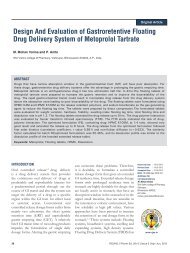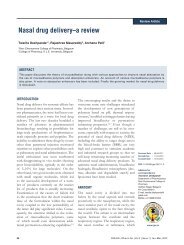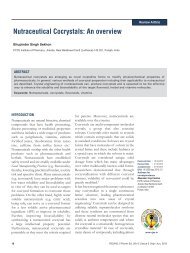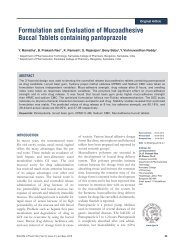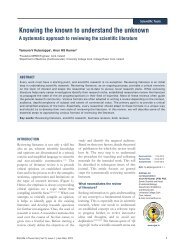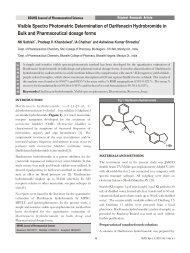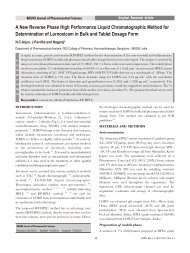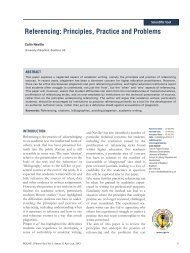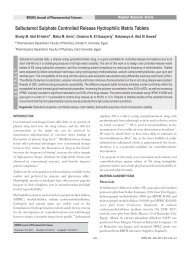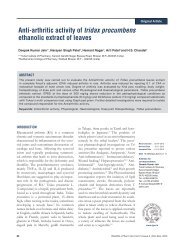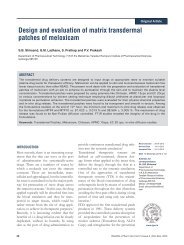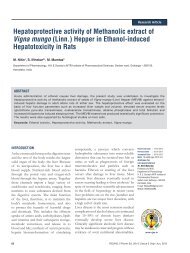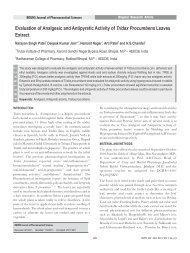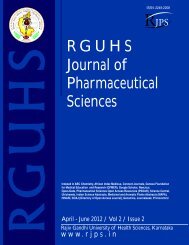Chitosan Loaded Mucoadhesive Microspheres of Gliclazide - Journal
Chitosan Loaded Mucoadhesive Microspheres of Gliclazide - Journal
Chitosan Loaded Mucoadhesive Microspheres of Gliclazide - Journal
Create successful ePaper yourself
Turn your PDF publications into a flip-book with our unique Google optimized e-Paper software.
2<br />
a 3 full factorial design was employed to study the effect <strong>of</strong><br />
independent variables i.e. polymer-to-drug ratio (X 1)<br />
and the<br />
stirring speed at rpm (X 2)<br />
on dependent variables %<br />
mucoadhesion, drug entrapment efficiency and particle size.<br />
In-vivo Anti-diabetic Study<br />
In-vivo evaluation studies for gliclazide mucoadhesive<br />
microspheres were performed on normal healthy wistar rats<br />
weighing 250 to 300 g each. The approval <strong>of</strong> the Institutional<br />
Animal Ethics Committee was obtained before starting <strong>of</strong> the<br />
study. Two groups <strong>of</strong> Wistar rats (5 in each group) that were<br />
fasted with water at least 12 hours before the experiments<br />
were used for the study. Before drug administration, a blood<br />
sample as a control was taken for each rat from behind the<br />
eyeball through the angle <strong>of</strong> ocular cavity using small<br />
capillary tubes. The blood glucose level for the control and test<br />
sample was determined using the glucose measuring<br />
instrument. The instrument was self calibrated, and the<br />
samples were allowed to dry before the results were read to<br />
avoid contamination <strong>of</strong> the lens. Pure gliclazide and<br />
mucoadhesive microspheres <strong>of</strong> gliclazide were administered<br />
orally to each group using stomach intubations. A dose <strong>of</strong> 800<br />
g/kg <strong>of</strong> gliclazide was administered in suspension form for<br />
each rat. Blood samples were collected at predetermined time<br />
at 1 hour intervals up to 24 hours, and the blood glucose level<br />
was performed as per method described earlier. The<br />
31-32<br />
percentage reduction in blood glucose level was measured .<br />
Stability Testing<br />
Optimized formulations <strong>of</strong> microspheres were tested for<br />
stability studies. Both the formulations were divided into 3<br />
sample sets and stored at 4±1°C, 25±2°C and 60±5% RH<br />
and 37±2°C and 65±5% RH. After 30 days, in vitro drug<br />
release studies and percentage entrapment efficiency were<br />
determined.<br />
RESULT AND DISCUSSION<br />
A Senthil et al./ <strong>Chitosan</strong> <strong>Loaded</strong> <strong>Mucoadhesive</strong> <strong>Microspheres</strong> <strong>of</strong> <strong>Gliclazide</strong>: In vtro and In vivo Evaluation<br />
The gliclazide mucoadhesive microspheres were prepared by<br />
simple emulsification phase separation technique using<br />
chitosan as natural polymer. Acetic acid from 1% to 6% v/v<br />
was used to prepare polymer solution. But there was no effect<br />
in concentration <strong>of</strong> acetic acid was observed on percentage<br />
mucoadhesion or drug entrapment efficiency, therefore 1%<br />
v/v <strong>of</strong> acetic acid was used. Based on viscosity <strong>of</strong> polymers<br />
solution three different concentrations 0.5, 1 and 2% v/v were<br />
selected for trial batches, from this 1% concentration showed<br />
a maximum sphericity was observed so we select 1% w/v <strong>of</strong><br />
polymer in 1% v/v acetic acid was found to be the optimum<br />
concentration and 1:1 heavy and light paraffin was used as<br />
dispersion medium and 0.2% dioctyl sodium sulfosuccinate<br />
165<br />
surfactant to dispersion medium was found to be essential to<br />
minimize aggregation <strong>of</strong> microspheres. Cross-linking agent<br />
glutaraldehyde was selected due to its high rate <strong>of</strong> crosslinking<br />
and increased in glutaraldehyde concentration caused<br />
highly cross-linked spheres and become dense by hardening<br />
process. The long term exposure to 100 ppb glutaraldehyde<br />
vapour cause respiratory tract lesions including hyperplasia<br />
<strong>of</strong> squamous epithelium therefore, it is important to remove<br />
excess <strong>of</strong> glutaraldehyde from the microspheres to avoid any<br />
toxic reactions. The chitosan microspheres are a useful tool to<br />
improve the uptake <strong>of</strong> hydrophilic substance across epithelial<br />
layer. The glutaraldehyde was deposited on the surface <strong>of</strong><br />
microspheres so easy removal <strong>of</strong> the unreacted free<br />
33<br />
glutaraldehyde as reported by Sahin et al .<br />
Preliminary trail batches <strong>of</strong> microspheres were prepared by<br />
using chitosan as polymers, the volume <strong>of</strong> cross-linking agent<br />
10 to 70 mL and stirring speed were varied from 500, 1000<br />
and 1500 rpm. From these batches F13, 60 mL <strong>of</strong> crosslinking<br />
agent and 1 hour cross-linking time was the optimum<br />
amount and time used for the preparation <strong>of</strong> mucoadhesive<br />
microspheres. Increase in the cross-linking time (1 to 4 hours)<br />
was inversely affected the percentage mucoadhesion. The<br />
cross-linking chitosan mucoadhesive polymer probably<br />
becomes more rigid and thus mucoadhesiveness decreases.<br />
The cross-linking time did not have a significant effect on the<br />
percentage drug entrapment efficiency were shown in (Table<br />
1).<br />
2<br />
On the basis <strong>of</strong> the preliminary trials 3 full factorial design<br />
were employed, to study the effect <strong>of</strong> independent variable X 1<br />
(polymer-to-drug ratio 1:1, 3:1 and 6:1) and the stirring speed<br />
X 2 (500, 1000 and 1500 rpm) on dependent variables<br />
percentage mucoadhesion, drug entrapment efficiency and<br />
particle size. The results depicted in (Table 2) clearly indicate<br />
that all the dependent variables are strongly dependent on the<br />
selected independent variable as they show a wide variation<br />
among the nine batches.<br />
Factorial Equation for Drug Entrapment Efficiency<br />
and Particle Size<br />
The drug entrapment efficiency was an important variable for<br />
assessing the drug loading capacity <strong>of</strong> microspheres and their<br />
drug release pr<strong>of</strong>ile, thus suggesting the amount <strong>of</strong> drug<br />
availability at site. The following polynomial equation was<br />
derived by multiple regression analyses <strong>of</strong> the data.<br />
2 2<br />
Y = 69.11 + 10.01 X1 - 2.91 X2 - 0.484 X1 -7.03 X2 - 0.38 X1 X2<br />
The drug entrapment efficiency <strong>of</strong> chitosan loaded<br />
mucoadhesive microspheres varied from 49% to 54%, 66% to<br />
72%, and 70% to 77% at lower, medium and higher levels <strong>of</strong><br />
RJPS, Jul - Sep, 2011/ Vol 1/ Issue 2



